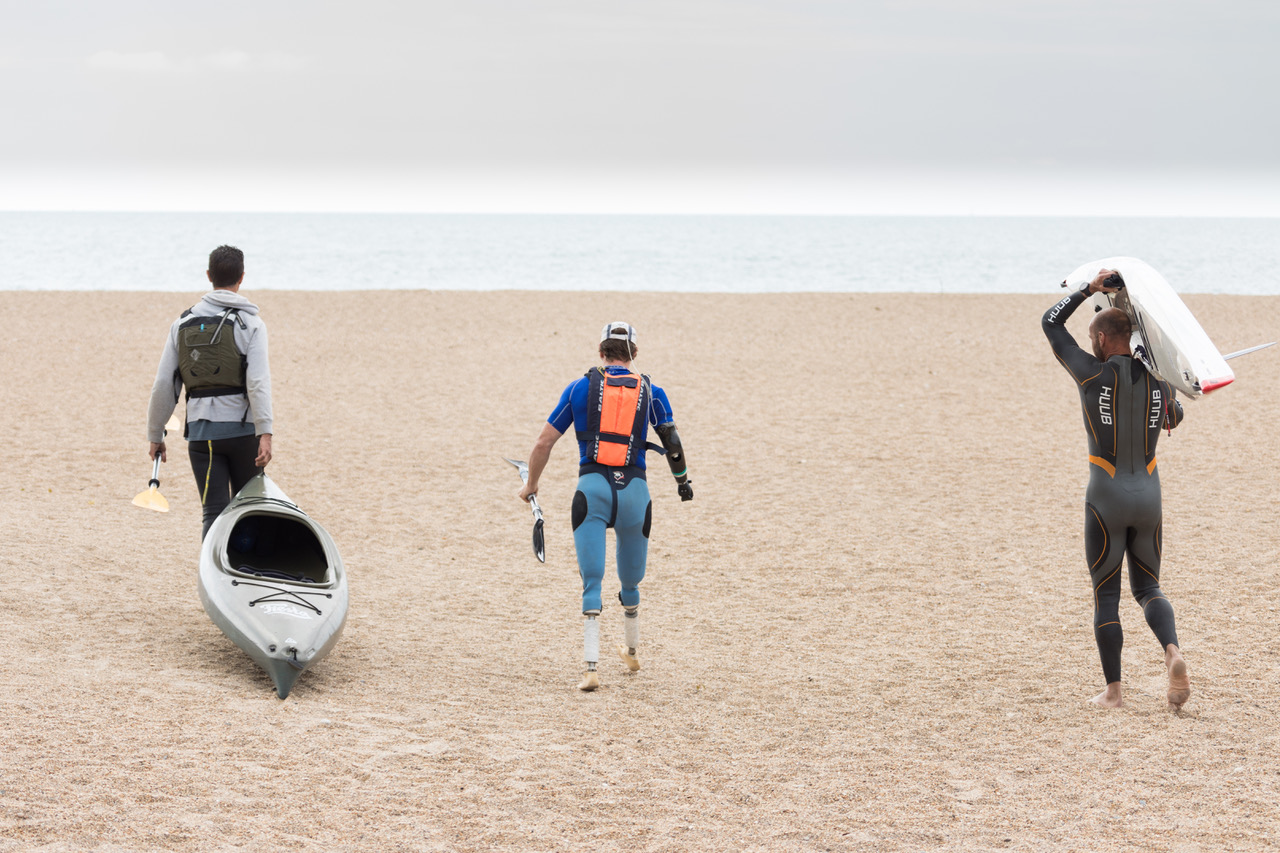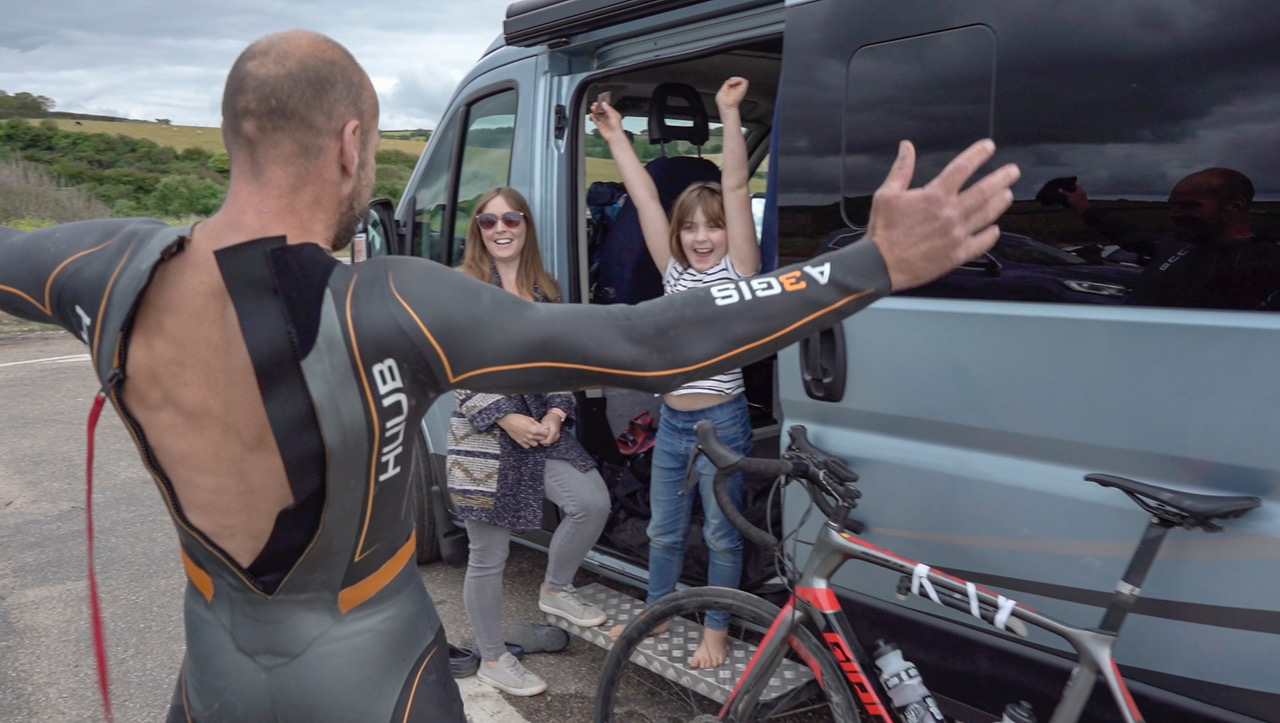How to create your own triathlon
Monty Halls’ ultimate ways of building a DIY triathlon

Amongst the gloom of cancelled races in 2020, rays of light have come from triathletes creating their own DIY triathlons. From Jan Frodeno’s indoor iron to Jonas Deichmann swim, bike and running the whole of Germany, triathlon’s famous ingenuity has once again been on display.
Now added to this list is broadcaster and inspirational speaker Monty Halls’ lockdown iron-distance event in South Devon, which attracted ultra runners, Everest mountaineers, global sporting icons, and serving members of the elite forces to the West Country to take one of the UK’s toughest 226km courses (total bike and run elevation was a Tenby-topping 3,477m).
In the process, the event has so far raised thousands to support military veterans and is set to return as a “full-blown event” in 2021.
Here are Monty’s essential tips for creating your own do-it-yourself iron race, from mapping to safety measures and the importance of a support crew.
1. IRON MOTIVATION
Anyone who attempts an iron-distance event needs motivation, some elemental force that equips the athlete to tackle the training and the event itself. But to organise it as well? That requires a little extra something and, in this case, it was the inspiration provided by the military veteran community. I’m extremely fortunate to know a few of the Royal Marines veterans personally, and they are indefatigable, undaunted, driven, and supremely focused. Their example fuelled my own modest efforts throughout.
There was also the simple frustration that this was the third year running that I’d missed out on doing an iron-distance event, added to an increased appreciation of our local environment through lockdown. The result was a ‘If you build it, they will come’ mentality.
2. COURSE CONSTRUCTION
There weren’t many parts of this process that were presented to us on a plate, but this aspect was the easiest of all. You need a big wet thing to swim in, a road to bike on, and a path to stagger along. Myself and the iron-distance coach extraordinaire, Rory Aitken, had already been training locally and, as we live by the sea, it didn’t take a genius to figure out the route.
It happened over a coffee as we considered (yet another) event being cancelled as lockdown began to take hold. In a caffeine-fuelled Eureka moment, a glance to the left revealed the sea, a glance to the right revealed the South West Coast Path, and a glance at each other revealed the plan. Sod it, we’d do it anyway.
It was only as we mapped out the course that we realised how cheeky the whole thing was going to be. It’s not one gigantic hill in particular, more of relentless serried ranks of up and down, a rollercoaster of jagged, eroded coastline that creates a squeaky-bum level of overall altitude gain. But, spookily, the course kind of created itself. It was precisely 3.8km between our favourite bays, exactly 45km round our usual cycle route (so four laps then), and 21km on the path out to a prominent headland.

3. THE IMPORTANCE OF THE SUPPORT CREW
My advice would be to pick a few people that you trust 100%. With something so positive and life affirming as “We’re going to organise a local iron-distance challenge to raise money for our military veterans….” everyone suddenly wants to get involved. But, when push comes to shove, there are those that deliver, and those that abruptly find it all a bit inconvenient. In summary, does enthusiasm translate into action? It’s the question that draws a stark line between success and failure.
There were a few absolute legends involved in putting our event together. Rory Aitken, Andrew Jarrold, Linda Torbet, Shaun and Andrea Parkin, the SHAW crew, Daff, Jon, CG, Huel, Ventura, Felix, and Lewis. Wiggers also played a blinder, as did Mick, Nick, Par, and a host of kayakers.
4. SAFETY PRECAUTIONS
We were – by necessity – fairly Corinthian in our approach to the event. As word spread, more and more people wanted to become involved, but we made it really clear from the outset that this wasn’t a formal race, and that they needed to provide their own safety support. We had a pretty good safety set up nonetheless – these were Royal Marines helping us out, who have a fairly good idea of what’s required working with tired people in challenging terrain. There was a kayaker for every two swimmers, a medic on standby with an off-road motorbike to get him to even the most challenging parts of the course, and a Race HQ with a physio, and some very, very hairy-bummed individuals with some impressive battlefield medic qualifications.
Even with all this, we got every participant to sign a liability waiver before starting, noting that this was a charitable race to raise money, taken on voluntarily in the full knowledge that there was no formal support structure in place. All this will change in 2021, when it becomes a proper, full-blown event.
5. PICKING THE ATHLETES
We decided to do the event by invitation only, with the main pre-requisites being raising some money for the charity, as well as having something vaguely horny-palmed in their race CV (an ultra, an Ironman, or Special Forces experience). Bucking this trend was Martin Johnson, legendary England and Lions rugby union skipper. He got in touch to say he’d like to do the bike leg, is 6’7”, 115kg, and still has the glower. So I said yes. He also, I should hastily add, smashed the bike route, and rode with me and my mate Andrew throughout. Drafting isn’t legal in Ironman, of course. It’s also utterly unavoidable when the bloke in front of you has a back the size of a sight-screen.
And so, as I stood to address the competitors at the race briefing, I was looking at: A global sporting icon. An Everest Mountaineer. A Guinness World Record Holder for Marathons on all Seven Continents. A World Record Ocean Rower. Special Forces Veterans. Royal Marine Commandos. And… a couple of my mates who said they’d give it a crack, and were sitting at the back of the room looking a tad sheepish. Next year’s event is open to anyone and everyone, but this was a great bunch to have as pioneer athletes.

6. EMBRACING FAMILY SUPPORT
As anyone, anywhere will tell you, it’s impossible to get an iron-distance event under your belt without the support of your family. Mine were simply wonderful, with my wife Tam sitting me down at the start of training and asking me exactly what the best way would be to support the process, and then doing exactly that. Isla (6) and Molly (8) were initially very impressed, then very, very bored with it all. One of the hardest aspects of the whole thing wasn’t so much the investment of time that the training took, thus depriving me of hanging out with the kids, but also the fact that when I did see them, I was too knackered to play properly. An Ironman’s essentially a selfish process, and no-one pays a bigger price than your family. Tam and the girls have now been told officially by me that they can do whatever they want for the rest of their lives, and I’m duty bound to support them.
7. FINDING A DATE
This was remarkably easy. As my original, COVID-kiboshed, event was on 26 July, we did the Royal Marines Iron Challenge on the same date. Come hell or high water, we were going ahead then, and fortunately the day dawned bright and crystal clear. It was a tad windy, which made the bike route emotional at times, but then the weather gods were kind enough to add a light mist of rain for the Coast Path marathon. The tides also gave us a gentle aquatic shove up the rear end on the swim. So, overall, we were damn lucky with the weather, the timings, and the day itself.
8. MAKING IT COVID-SECURE
Again, this was one we were very clear about from the off. We could’ve had fifty folks doing the whole race, but we kept it to only eight because of Covid. Others did the swim leg, the bike leg, or the run individually, but generally we kept the numbers really low. Every competitor operated in their own support bubble, with the only time we all came together being the race briefing in the local village hall (and even there we could maintain social distancing).
In short, we were aware of: a) the responsibility of giving out the right message, and: b) how key it was that no-one got infected. As the race winner beat me by 5:30hrs, I can honestly say that social distancing between us was impeccably observed.
9. HOW TO PROMOTE IT
From the outset we made it a pre-requisite that every competitor, whether doing the whole race, or just a section of it, had to raise money for the charity. This in turn meant that those same competitors had to use social media, speak to their local papers, and generally make a bit of a fuss. As such word spread very quickly.
We didn’t actually have a formal PR plan, but I do for 2021’s event. Come and join us next year on 30 May to tackle one of the most beautiful, dramatic, challenging iron-distance courses on Planet Earth. Come and be part of a unique group of people and raise money in the process to support our veterans and their dependents. Come along, share the experience of this great new event, and give it an almighty crack.
Monty Halls’ 2021 iron-distance event will take place on 30 May in South Devon. You can donate to his Just Giving page here.




